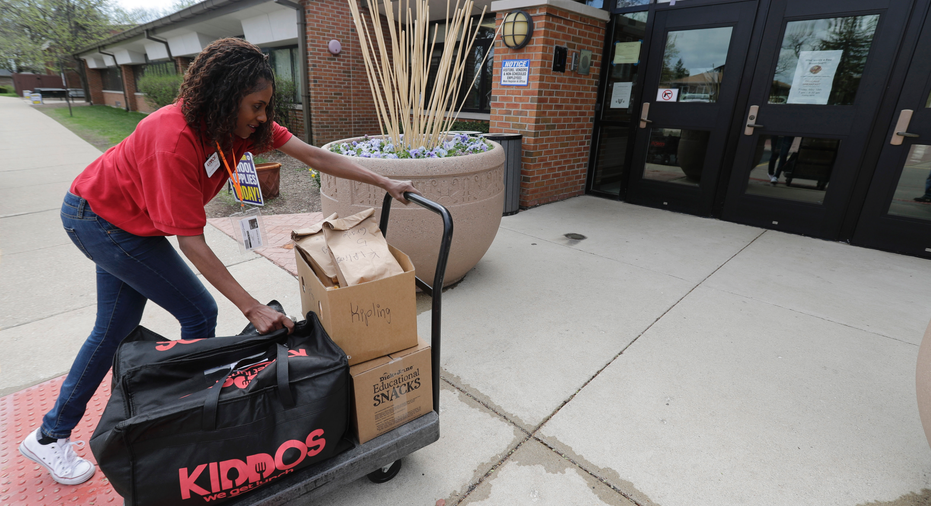Food deliveries are remaking school lunch

Rachel Harrington wants her children to have nutritious packed lunches to enjoy at school but she gets frustrated trying to create them.
"Making lunches for my kids is one of my least favorite activities. I'd like to do it the night before, but that never happens," said the mother of two. "There are a lot of complaints."
It's a chore she's happy to outsource two days a week to a business in her hometown of Lexington, Massachusetts. "Having two days off is like a dream," she said. "Sometimes I forgot that it's a Red Apple Lunch day. When I realize I do not have to make lunches, I'm so happy."
Families around the country are finding new options for their children's midday meal thanks to a growing number of delivery options catering to students. Some deliver to the schools, others to homes. As for teens calling in their own food deliveries, some schools allow it and others don't.
Lisa Farrell launched Red Apple Lunch after market research confirmed her suspicion that lunch packing was a "stress point" for parents. "You only have so much time in the day," she said. "Some customers didn't like what was offered at school. Folks just needed another option."
She and her team pack healthy lunches, incorporating local food when possible, and deliver them to homes so that kids can take them to school the next two days. The company delivers two lunches on Monday and two on Wednesday.
Many of Farrell's clients also have the option of buying a hot lunch provided by their child's school, but not all schools offer that.
Kiddos Catering in Chicago has come up with a different twist: providing restaurant meals to schools that contract with it. Owner Michelle Moses and her staff work with area restaurants to create a variety of kid-friendly choices, and deliver the meals to the schools five days a week. Parents select the lunches from an online order form that lists the day's featured restaurant and its menu choices.
"Each day is a different restaurant with six to 10 menu options," she said. "It offers so much choice to kids."
The service appeals to parents because they think their children are less likely to toss out restaurant food than a packed lunch, Moses said. Sarah Goldman, who uses the program at Kipling Elementary School in Deerfield, Illinois, agreed.
"I know my kids are going to eat because they love it," she said. "I know they're finishing their lunch."
The schools appreciate that Moses handles the ordering, payment, pickup and food distribution in the cafeteria.
"Schools really want to be in the business of educating kids," she said. "They don't want to be in the food and beverage business."
That doesn't mean that schools always like it when teens (or parents) take it upon themselves to order food through phone apps. Many schools have banned that practice, citing safety concerns about delivery drivers showing up at school unannounced and the burden of tracking down students to alert them that their meals have arrived.
"These types of deliveries pose an unnecessary security risk for students and staff," said Bernard Watson, director of community relations for Gwinnett County Public Schools in Suwanee, Georgia. "In addition, our award-winning school nutrition program provides students with a wide variety of tasty, nutritious meals on-site, so there is no need to order food from outside."
But in places where there is no formal policy about restaurant deliveries, they can come in handy. When Spencer Wood's daughter forgot her lunch last spring, he arranged for the local Panera to deliver her a meal.
"I called the school to make sure it was OK, and they said families do it all the time," said Wood, of Canal Winchester, Ohio. "They were very helpful, telling me when to have it sent and reminding me to tip the driver. "
His 12-year-old daughter, Madison, loved the special delivery of macaroni and cheese, he said.
A restaurant meal is a nice treat, agreed Jacob Levin, a recent graduate of Bexley High School in Bexley, Ohio. He relied on a sub shop to deliver a sandwich to him during lunchtime meetings or other appointments that conflicted with his lunch period.
"It was a convenient option. In most cases, I would not have been able to eat at school if it weren't for the delivery option," he said. "Having a restaurant-quality sub also was much more enjoyable than cafeteria food."



















